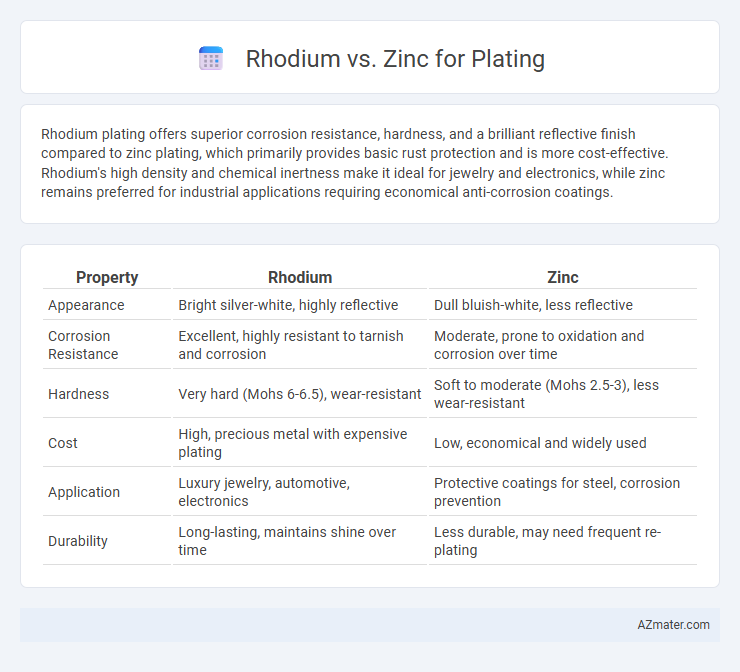Rhodium plating offers superior corrosion resistance, hardness, and a brilliant reflective finish compared to zinc plating, which primarily provides basic rust protection and is more cost-effective. Rhodium's high density and chemical inertness make it ideal for jewelry and electronics, while zinc remains preferred for industrial applications requiring economical anti-corrosion coatings.
Table of Comparison
| Property | Rhodium | Zinc |
|---|---|---|
| Appearance | Bright silver-white, highly reflective | Dull bluish-white, less reflective |
| Corrosion Resistance | Excellent, highly resistant to tarnish and corrosion | Moderate, prone to oxidation and corrosion over time |
| Hardness | Very hard (Mohs 6-6.5), wear-resistant | Soft to moderate (Mohs 2.5-3), less wear-resistant |
| Cost | High, precious metal with expensive plating | Low, economical and widely used |
| Application | Luxury jewelry, automotive, electronics | Protective coatings for steel, corrosion prevention |
| Durability | Long-lasting, maintains shine over time | Less durable, may need frequent re-plating |
Introduction to Rhodium and Zinc Plating
Rhodium plating is a highly reflective, corrosion-resistant finish primarily used in fine jewelry and electronic connectors due to its exceptional hardness and brilliant white sheen. Zinc plating provides a cost-effective corrosion barrier commonly applied to automotive parts, fasteners, and industrial components, offering sacrificial protection through its anodic nature. Both metals enhance durability and appearance, but rhodium excels in aesthetic value while zinc prioritizes corrosion prevention.
Chemical Properties of Rhodium vs Zinc
Rhodium exhibits exceptional corrosion resistance and high reflectivity due to its inert chemical nature and platinum-group properties, making it ideal for plating applications requiring durability and a bright finish. Zinc, a more reactive metal, forms a protective oxide layer that prevents further corrosion but has lower hardness and reflectivity compared to rhodium. The significant difference in electronegativity and atomic structure between rhodium (a noble metal) and zinc (a post-transition metal) directly influences their chemical stability and plating performance.
Plating Process Comparison
Rhodium plating involves a complex electroplating process using a rhodium electrolyte bath that offers superior corrosion resistance and a highly reflective finish ideal for fine jewelry and electronics, while zinc plating utilizes a simpler and more cost-effective electrolytic or hot-dip process primarily aimed at providing robust sacrificial protection against rust in industrial applications. Rhodium plating requires precise control of temperature, current density, and bath composition to achieve uniform coatings, whereas zinc plating operates at relatively lower parameters with faster deposition rates, making it suitable for large-scale metal protection. In terms of durability, rhodium forms an extremely hard, wear-resistant surface, whereas zinc plating offers moderate hardness but excels in galvanic protection by corroding preferentially to the substrate metal.
Corrosion Resistance: Rhodium vs Zinc
Rhodium plating provides superior corrosion resistance compared to zinc, as it is highly inert and resists oxidation and tarnishing even in harsh environments. Zinc plating offers sacrificial protection by corroding first to protect the underlying metal but is less effective over long periods, especially in acidic or salty conditions. For applications demanding durable and corrosion-resistant finishes, rhodium plating is preferred for its hardness, chemical stability, and minimal maintenance requirements.
Durability and Longevity
Rhodium plating offers superior durability and corrosion resistance compared to zinc, making it ideal for high-wear applications and jewelry with long-term exposure to moisture and chemicals. Zinc plating provides moderate protection against rust and is commonly used for industrial parts, but it tends to wear and deteriorate faster under harsh conditions. The longevity of rhodium plating typically extends several years longer than zinc, preserving both appearance and structural integrity.
Visual Appearance and Finish
Rhodium plating offers a bright, reflective white finish with exceptional hardness and resistance to tarnish, making it ideal for high-end jewelry requiring a polished, mirror-like appearance. Zinc plating provides a matte to semi-gloss finish with moderate corrosion resistance, commonly used for industrial and functional metal parts rather than aesthetic purposes. The visual appeal of rhodium is superior for decorative applications, while zinc prioritizes protection over detailed surface brilliance.
Cost Analysis: Rhodium vs Zinc
Rhodium plating commands significantly higher costs, often exceeding $1,000 per ounce due to its rarity and exceptional corrosion resistance, making it ideal for luxury jewelry and high-end automotive parts. Zinc plating remains economically favorable, costing just a few dollars per pound, suitable for large-scale industrial applications where cost-efficiency and moderate corrosion protection are priorities. The price disparity stems from rhodium's scarcity and superior durability compared to zinc's abundant availability and basic protective qualities.
Ideal Applications for Each Metal
Rhodium plating is ideal for high-end jewelry, automotive components, and electronic connectors due to its exceptional hardness, corrosion resistance, and brilliant reflective finish. Zinc plating is best suited for industrial and automotive parts requiring cost-effective corrosion protection and sacrificial anode properties in harsh environments. Both metals offer distinct benefits, with rhodium excelling in aesthetics and durability, while zinc provides economical and functional surface protection.
Environmental Impact and Safety
Rhodium plating offers superior corrosion resistance and a non-toxic finish, but its extraction is energy-intensive and involves rare, precious metals with limited recyclability. Zinc plating provides effective rust prevention through sacrificial protection, utilizing abundant resources with lower environmental extraction costs and generally safer handling procedures. Both metals require proper disposal measures, but zinc's widespread availability and less hazardous mining process make it a more environmentally sustainable and safer option for large-scale industrial plating applications.
Choosing the Right Plating: Factors to Consider
When choosing between rhodium and zinc plating, factors such as corrosion resistance, appearance, and cost must be prioritized. Rhodium plating offers superior durability and a brilliant, reflective finish ideal for jewelry and high-end applications, while zinc plating provides effective corrosion protection at a lower cost, making it suitable for automotive and industrial components. Consider environmental exposure, aesthetic requirements, and budget constraints to select the optimal plating material.

Infographic: Rhodium vs Zinc for Plating
 azmater.com
azmater.com